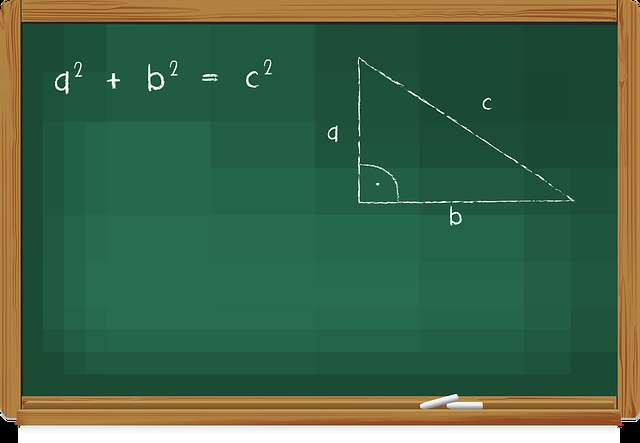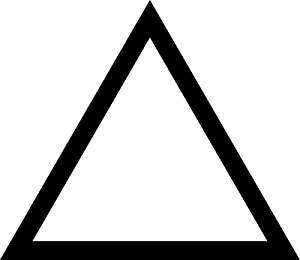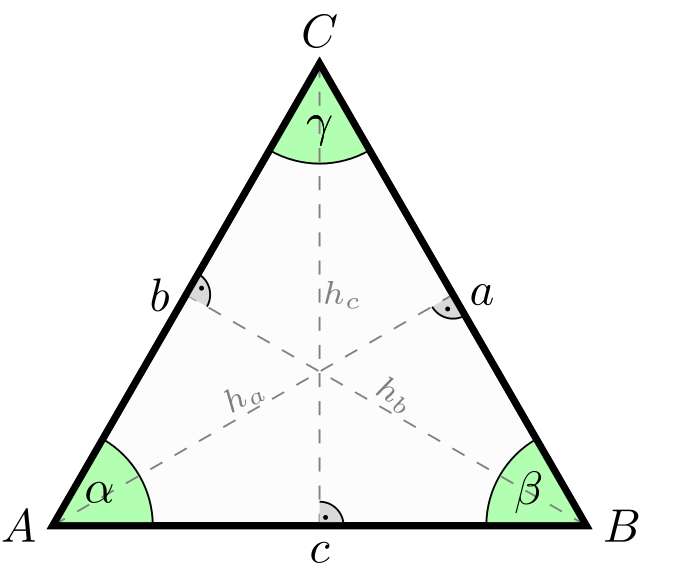Triangle Calculator
Instructions: Use this calculator to solve a triangle providing three pieces of information, either two sides and an angle, two angles and the side encompassed, or three sides. Please provide three pieces of information in the boxes below.
More on this this Triangle Calculator
Triangles are one of the crucial objects in Geometry, and they have provided a fertile ground for the development of the logical argumentation machinery used in much of modern Math.
This calculator will aid you to solve a triangle showing all the steps after you provide sufficient information to calculate it, which specifically means to provide three pieces of information. You can provide all three steps, OR, you can provide two sides and the angle between them, OR, two angles and the corresponding opposite side.
Once you provide a the required information, the only thing that is left is to click on "Calculate" and then the calculator will show you all the steps of the process.
How do you Calculate a Triangle
Using this triangle calculator is straightforward. You will need to input the known values of your triangle, such as the lengths of sides or angles. Here's how you can do it:
- Think of the type of information you have provided. Do you have some kind of symmetry there? Use that to get at least 3 pieces of information.
- Enter the known values. For example, if you know two sides of a right triangle, enter those and enter an angle of 90 degrees.
- Click 'Calculate' to get the results, with all steps shown.

Types of Triangles and Their Calculations
Often times, and strictly in terms of the calculation process, you do not need to know the specific type of triangle you are dealing with, provided that you are able to have three pieces of information.
On the other hand, knowing the type of triangle can give you immediately all the information you need, and perhaps you won't even need a calculator. For example, if you know that your triangle is equilateral, you can assume immediately that all three angles are equal to 60 degrees, and then all you need to know is one side.
Right Triangle Calculator
A right triangle has one angle equal to 90 degrees. Here are some common calculations:
Calculate the Hypotenuse
- Enter the lengths of the two legs.
- Use the Pythagorean theorem: \(c = \sqrt{a^2 + b^2}\).
- Use the sides and hypotenuse, along with trig functions to get the two missing angles
Scalene Triangle Calculator
Scalene triangles are those triangles that have all sides of different lengths and all different angles. Here's how you can calculate:
Find the Area
- Enter the lengths of all three sides.
- Use Heron's formula: \(A = \sqrt{s(s-a)(s-b)(s-c)}\), where \(s\) is the semi-perimeter.
Naturally, Heron's formula applies to all kind of triangles, not only scalene triangles.
Equilateral and Isosceles Triangle Calculations
Equilateral triangles have all sides equal, while isosceles triangles have at least two sides equal. Here's how to calculate:
Calculate the Area of an Equilateral Triangle
- Enter the length of one side.
- Use the formula: \(A = \frac{\sqrt{3}}{4}a^2\).
As we mentioned before, for an equilateral triangle you know that all angles have the same measure, which equals 60 degrees, and hence, only the size of the common side is required. With the side you can get the height directly using the Pythagorean Theorem, and then find the area in terms of the side only.

Calculating Triangle Sides
Using the Pythagorean Theorem
The Pythagorean theorem is used for right triangles to find the length of a side when the other two sides are known, assuming you have a right triangle:
- Enter the lengths of the two known sides.
- Calculate the unknown side using \(a^2 + b^2 = c^2\).
- For non-right triangles you need to use the law of cosines instead \(a^2 + b^2 = c^2\).
Law of Sines and Cosines
For non-right triangles, you can use:
- Law of Sines: \(\frac{a}{\sin A} = \frac{b}{\sin B} = \frac{c}{\sin C}\)
- Law of Cosines: \(c^2 = a^2 + b^2 - 2ab \cos C\)
Area of a Triangle Calculator
Base and Height Method
If you know the base and height of a triangle:
- Enter the base and height.
- Calculate the area using \(A = \frac{1}{2} \times base \times height\).
This formula looks simple enough, but this requires knowing the height, which is not always known nor easy to compute at times, especially for scalene triangles.
This shortcoming is solved by using Heron's formula, which is explained in the next section.
Heron's Formula
One of the biggest advantage of Heron's formula is that you do not need to explicitly compute the height. Indeed, when you know all three sides:
- Use the three sides to compute the semiperimeter.
- Use Heron's formula as mentioned earlier.

Advanced Triangle Properties
Median, Inradius, and Circumradius
These properties provide deeper insights into triangle geometry:
- Median: The line segment joining a vertex to the midpoint of the opposite side.
- Inradius: The radius of the inscribed circle, calculated using \(r = \frac{A}{s}\), where \(A\) is the area and \(s\) is the semi-perimeter.
- Circumradius: The radius of the circumscribed circle, given by \(R = \frac{abc}{4A}\).
Common Triangle Calculations
How to Find the Missing Side of a Triangle?
If you know two sides and an angle, use the Law of Cosines to find the missing side:
- Enter the known sides and angle.
- Calculate using \(c^2 = a^2 + b^2 - 2ab \cos C\).
The 45-45-90 Triangles
In a 45-45-90 triangle, you have a right triangle, the legs are equal, and the hypotenuse is \(a\sqrt{2}\):
- Enter the both legs as the known sides.
- Calculate the hypotenuse using \(c = a\sqrt{2}\).
- Use 90 degrees as the known angle.
Frequently Asked Questions
What are the different types of triangles?
Triangles are classified by their sides and angles:
- Equilateral: All sides equal, all angles 60 degrees.
- Isosceles: Two sides equal, two angles equal.
- Scalene: All sides different, all angles different.
- Right: One angle is 90 degrees.
- Obtuse: One angle greater than 90 degrees.
- Acute: All angles less than 90 degrees.
How do you calculate the area of a triangle?
There are several methods:
- Base and Height: \(A = \frac{1}{2} \times base \times height\)
- Heron's Formula: \(A = \sqrt{s(s-a)(s-b)(s-c)}\)
- Using trigonometry: \(A = \frac{1}{2}ab \sin C\)
Can a triangle have more than one right angle?
No, a triangle can only have one right angle because the sum of the angles in any triangle must be 180 degrees.
Explore More Triangle Calculators
If you're dealing with triangles and need to explore different scenarios, our suite of triangle calculators can be incredibly useful. For instance, if you're working with a right triangle, our Right Triangle Calculator can help you find all the necessary angles and sides with ease.
Additionally, if you're in a situation where you know two sides and the angle between them, our Triangle Calculator for Two Sides Known and the Angle between them will provide you with the remaining information you need.
Another common scenario involves knowing all three sides of a triangle. Here, our Triangle Calculator with three sides known can be particularly handy, allowing you to calculate the angles without any additional input. This tool is perfect for when you're dealing with real-world measurements or geometric constructions where all sides are given.





